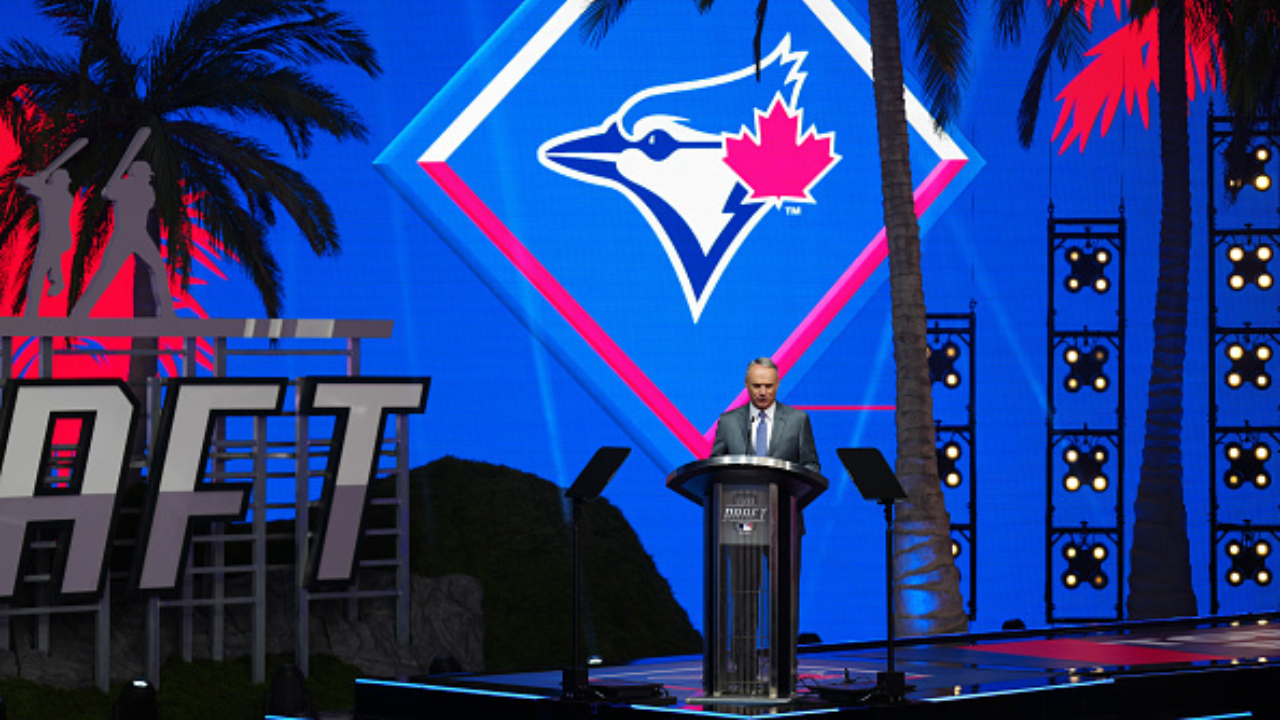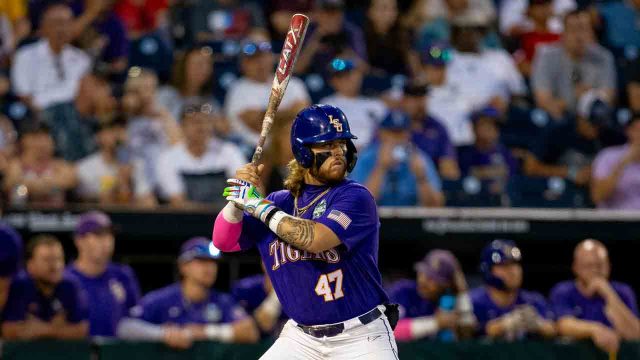
FORT WORTH, Texas – At 1.5 fWAR of value and counting, Spencer Horwitz would very clearly be chosen much higher than the 24th round, 717th overall, if the 2019 draft were to be redone.
How much higher is interesting to ponder, and here’s just how wild the projection business really is: Of the 30 players selected in the first round, seven have yet to touch the majors, while 11 others have less fWAR than him.
“Why are we taken later would be the question,” the Toronto Blue Jays utilityman says of late-round picks who reach the majors. “Tools are sexy, I guess. You look at me, I pretty much have one tool – hit – and it’s a pretty important one if you ask me. They’d rather have, typically, an 18-year-old in the first round that’s fast, throws hard and can hit the ball a mile but isn’t really hitter-ish. I understand why. They trust their player development to turn them into something. That makes a lot of sense to me. But something that’s hard, I think, is the word potential. It’s pretty tough. Essentially, you’re asking what is someone’s potential? And a lot more goes into it than just the physical. It’s a lot about the person.”
Very much so and figuring out the person remains such an inexact science that all 30 teams are going to make multiple mistakes – taking some players too high, others too low – during the 20-round Major League Baseball draft that begins Sunday evening.
Take the current Blue Jays roster, for example. Two-time all-star closer Jordan Romano was the club’s 10th-round pick in 2014. Chad Green was a Tigers 11th rounder in 2013. Chris Bassitt (2011, White Sox) and Danny Jansen (2013, Blue Jays) were both 16th rounders. Davis Schneider was a Blue Jays 28th rounder in 2017. Kevin Kiermaier a Rays 31st rounder in 2010. Trevor Richards wasn’t drafted at all before signing with the Marlins in 2016.
In total, they’ve combined for 71.9 fWAR during their careers so far.
To frame how remarkable that is, consider the following: Of the 715 players on opening day rosters to come through the draft, 316 of them, or 44 per cent, were among the top 90 picks; 447 of them, or 62.5 per cent, were selected in the first five rounds; and 562 of them, or 78.6 per cent, were chosen within the first 10 rounds.
There are two key takeaways for clubs within that – one, you can’t be an elite organization if you aren’t excelling where the bulk of players are coming from; and two, no pick, especially now that the draft is just 20 rounds, should be a lazy flier because there’s always someone waiting to be found.
To the first point, the Blue Jays have more opportunity to be creative than they did last year, because not only did they not have to surrender a pick for signing a qualified free agent, they also have a compensation pick (136th overall, between round four and five) for Matt Chapman’s departure as a free agent.
At $8,987,000, they’ll have the 23rd largest signing bonus pool to work with, a slight improvement over last year, when their pool was 26th, but still far off 2022, when they had compensatory picks for the departures of Robbie Ray and Marcus Semien and worked from the 16th biggest pool.
Those extra picks, Nos. 77 and 78 overall, turned into infielders Tucker Toman (low-A Dunedin) and Cade Doughty (double-A New Hampshire), as the Blue Jays manipulated their bonus pool to take some extra shots at higher-risk players.
The Blue Jays also did that last year, going under slot with first-rounder Arjun Nimmala and a few others and spreading the difference around, spending $300,000 over slot to land third-rounder Juaron Watts-Brown and nearly $1 million over to get fourth-rounder Landen Maroudis, whose promising season was cut short by elbow surgery.
They may be even more aggressive this year, too.
Whether it makes more sense to load up financially for one player at the top of the draft or spread the wealth across multiple rounds is an evergreen debate, one that for the Blue Jays, “depends on the players that are available and the options that you have in that round,” according to amateur scouting director Shane Farrell.
“If you’re very much aligned on the information for a given prospect and you feel like it’s the right decision to maybe extend, that should be a collective decision made by the group to go in that direction,” he continues. “Alternatively, if it is the best decision to try to save money and that’s what the information is telling us to do, we have to commit to that road as well. A lot of it is fairly circumstantial and who’s available where you’re picking.”
That’s where the Blue Jays’ evaluations need to be nails and their record since 2016 is spotty, as colleague Ben Nicholson-Smith demonstrates in this deep dive.
More late-round finds like Horwitz and Schneider would help, and the Blue Jays have more than enough players on their roster to draw some meaningful lessons from.
Such as, what did the industry miss?
“That’s a tough one answer,” says Jansen. “You always love stories of guys who are undrafted or go in the later rounds. Maybe that instills some more hard work. It’s a crazy thing. Looking back at myself, I was a super raw. I was not as flexible. I had a lot of things to learn. I was just a raw talent. Going in the 16th round, I think that was fair at the time.”
Romano describes himself as a “pretty stock righty” when he was drafted but believes “one of the biggest pieces that’s overlooked is character, in a sense. Yeah, there a lot of nice guys, whatever, but is this guy really a hard worker, is he a good teammate, is he a good clubhouse guy? If you’ve got a super-talented guy, but he’s not a good guy, he’ll make the big leagues for you, but then you’ll want to trade him. Is that a success? For me, I wasn’t throwing as hard. I guess the 10th round was the perfect spot for me.”
Bassitt calls himself “a really late bloomer,” who sat “mid-80s in high school, was a reliever in college, barely threw there, so it’s hard to say scouts did a bad job because I just wasn’t really out there.”
But, “to survive as a later-round pick and make it to the big leagues, it’s an opportunity to constantly prove yourself because at every single level, basically, they’re looking for a reason to cut you,” he adds. “I always enjoyed and embraced having to prove myself. Even to this day, even though I’m under contract, I still think I’ve got to prove myself.”
During his senior year of high school, Schneider felt he was “as good or better than the players that were there, but I didn’t stand out (physically).”
“I didn’t really hit the ball relatively hard – I hit it just enough to where it goes over the fence,” he continues. “I didn’t have a great arm. I was short and chubby. I didn’t look the part. I feel like I played really good defence. I thought I hit pretty well all the places I went to. I just didn’t have those standout tools everyone loves.”
One through line, then, is the individual determination and resilience each showed to overcome inevitable obstacles along the way.
Another is the work of scouts who do the type of digging that makes a difference. Like Wes Penick, who didn’t bail on Jansen when he missed nearly all of his senior year with a broken hand. Like Coulson Barbiche, who looked past a draft-year drop in Horwitz’s numbers to see in the underlying data that his season was far better than the stat-line showed.
Given an opportunity, Horwitz made sure to capitalize on it, with the help of some timely advice from Casey Candaele, now the Buffalo manager who was then the organization’s minor-league field co-ordinator and Vancouver skip.
“It was, ‘You all are given lottery tickets, some more than others, but you better figure out quick how many you have,’” recalls Horwitz. “That really stuck with me. I was like, yeah, I’m a 24th-rounder, 5-10, not fast, not a great defender, can only play limited positions. I realized I had to be really good at what I do.”
The same goes for everyone making picks during the draft, each trying to solve the game’s most enduring mystery.
“It’s like, what is the missing ingredient? It’s the billion-dollar question in baseball,” says Horwitz. “If you figure that out, let me know.”






